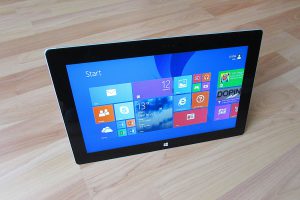Note : This page has been translated into English from French by a machine translation tool
Whether you are purchasing a desktop or a laptop, you will probably find yourself faced with the need to choose a screen. We will not discuss the features and their importance for your use here. We invite you to consult our article Technical characteristics of computers and tablets. We will only focus on the different types of screens and especially what are the advantages and disadvantages of each one. Small overview…
IPS screen
The IPS screen for “In-Plane Switching” has the particularity of offering excellent color rendering and a very nice viewing angle. It is a technology of LCD screens or liquid crystal displays. You have certainly noticed with your TV screen, your computer screen or even your smartphone that as soon as you look at it sideways its brightness decreases and the colors become dull. Some types of displays limit this phenomenon much better than others and this is the case with IPS displays. If you are a professional 3D modeler or a photographer, you can turn to this type of screen to benefit from faithful colors. On the other hand, this type of screen offers a lower refresh rate, in other words it is slower, which can be a disadvantage for players. Finally, it also has a lower contrast ratio, which can be a significant drawback if your screen is going to be used for videos, movies or series. If you find yourself in one of the latter cases, you should rather look at the following types of screens…
TN screen
The TN screen for “Twisted Nematic” is also an LCD screen technology that is very well adapted to video games thanks to very low response times and very high refresh rates. They are therefore able to display the image they receive very quickly but above all to do so with a very high frequency. On the other hand, as any technology that has strong advantages also generally has strong disadvantages, this technology is not optimal for displaying color rendering and offers very low viewing angles. To take advantage of their potential in an optimal way, you will thus have to position yourself well in front of your screen.
VA screen
The VA screen is the last type of LCD screen we will see here. It offers a very good contrast ratio and is therefore very suitable for watching movies and videos thanks also to a good management of its backlight. In general, the VA panel is less efficient in terms of response time, refresh rate or viewing angle. However, VA tiles have the widest variety of subtypes that improve each of the above characteristics.
The OLED screen
As you have seen in the previous points the different types of LCD screens have their advantages and disadvantages and this for one main reason, they require backlighting. It is the latter that makes your screen illuminate the room in which it is located when it is turned on in the dark but it is also and above all what makes your image visible. It is therefore among other things the way backlighting is managed that makes some less efficient than others on certain features.
You will no longer encounter these problems with OLED technology. Indeed, display and backlighting become one. As the name suggests, the image display is managed by organic light-emitting diodes, each with its own light, which means that each pixel is managed individually. They thus allow an exceptional contrast ratio, an excellent color rendering, very good viewing angles but also a very good display speed. But rare are the things that have no drawbacks. So, we must not forget one disadvantage of OLED which may be not negligible for some of you… its price.
To conclude, let’s not forget that the evaluation of the quality of an image is relatively subjective and that what we have seen previously will depend both on your level of requirement, on your use which will make you more or less feel the defects or qualities of a technology but also on your personal tastes. The ideal solution to judge the adequacy of a screen with what constitutes your definition of a beautiful image or a good level of display performance remains to experience it. So, when you can, check it out before you buy…









… [Trackback]
[…] Read More to that Topic: soft-hardware.fr/en/the-different-types-of-screens/ […]
… [Trackback]
[…] Read More on to that Topic: soft-hardware.fr/en/the-different-types-of-screens/ […]
Thank you for your sharing. I am worried that I lack creative ideas. It is your article that makes me full of hope. Thank you. But, I have a question, can you help me?
… [Trackback]
[…] Read More on that Topic: soft-hardware.fr/en/the-different-types-of-screens/ […]
… [Trackback]
[…] Find More Info here on that Topic: soft-hardware.fr/en/the-different-types-of-screens/ […]
… [Trackback]
[…] Information on that Topic: soft-hardware.fr/en/the-different-types-of-screens/ […]
… [Trackback]
[…] Find More on that Topic: soft-hardware.fr/en/the-different-types-of-screens/ […]
… [Trackback]
[…] Information to that Topic: soft-hardware.fr/en/the-different-types-of-screens/ […]
… [Trackback]
[…] Find More on to that Topic: soft-hardware.fr/en/the-different-types-of-screens/ […]
Your point of view caught my eye and was very interesting. Thanks. I have a question for you.
… [Trackback]
[…] There you can find 75043 additional Info on that Topic: soft-hardware.fr/en/the-different-types-of-screens/ […]
… [Trackback]
[…] Information to that Topic: soft-hardware.fr/en/the-different-types-of-screens/ […]
… [Trackback]
[…] Find More to that Topic: soft-hardware.fr/en/the-different-types-of-screens/ […]
… [Trackback]
[…] Read More here on that Topic: soft-hardware.fr/en/the-different-types-of-screens/ […]
… [Trackback]
[…] Here you can find 4958 more Information on that Topic: soft-hardware.fr/en/the-different-types-of-screens/ […]
… [Trackback]
[…] Information on that Topic: soft-hardware.fr/en/the-different-types-of-screens/ […]
… [Trackback]
[…] Find More here on that Topic: soft-hardware.fr/en/the-different-types-of-screens/ […]
… [Trackback]
[…] Info on that Topic: soft-hardware.fr/en/the-different-types-of-screens/ […]
… [Trackback]
[…] Find More Information here on that Topic: soft-hardware.fr/en/the-different-types-of-screens/ […]
… [Trackback]
[…] Info on that Topic: soft-hardware.fr/en/the-different-types-of-screens/ […]
… [Trackback]
[…] Here you will find 52452 additional Info to that Topic: soft-hardware.fr/en/the-different-types-of-screens/ […]
… [Trackback]
[…] Here you will find 6858 additional Information to that Topic: soft-hardware.fr/en/the-different-types-of-screens/ […]
… [Trackback]
[…] Read More here on that Topic: soft-hardware.fr/en/the-different-types-of-screens/ […]
… [Trackback]
[…] There you can find 73054 more Information to that Topic: soft-hardware.fr/en/the-different-types-of-screens/ […]
… [Trackback]
[…] Find More here to that Topic: soft-hardware.fr/en/the-different-types-of-screens/ […]
… [Trackback]
[…] Read More to that Topic: soft-hardware.fr/en/the-different-types-of-screens/ […]
I am an investor of gate io, I have consulted a lot of information, I hope to upgrade my investment strategy with a new model. Your article creation ideas have given me a lot of inspiration, but I still have some doubts. I wonder if you can help me? Thanks.